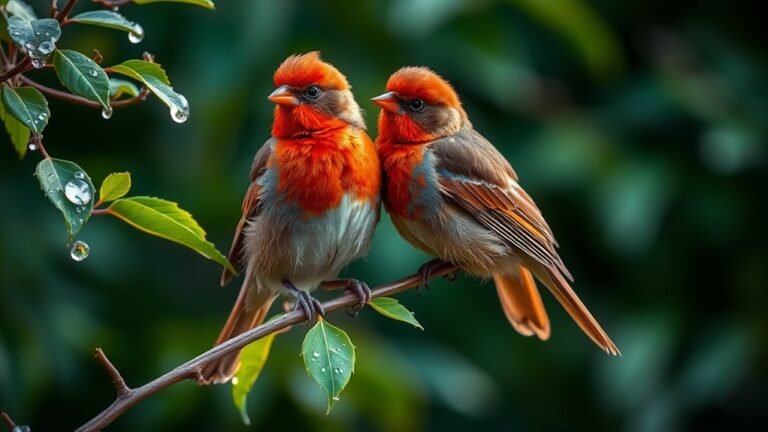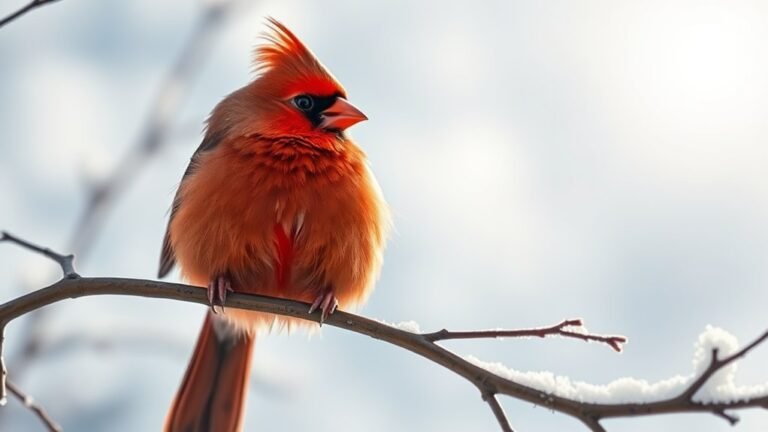10 Blue Birds in Washington State Guide
Washington State has a variety of blue birds that you can observe. The Mountain Bluebird stands out with its bright color and graceful presence. The Western Bluebird is another species that you may find; it is friendly and social. Look for the Violet-green Swallow too; it is known for its fast flying abilities. Each bird plays a role in the ecosystem, contributing to the area's biodiversity. Understanding these birds enhances your connection to nature. Let's look closely at some of these species.
Key Takeaways
Washington State hosts many beautiful blue birds, such as the Western Bluebird, Mountain Bluebird, and Indigo Bunting.
Western Bluebirds thrive in open woodlands. They nest in scattered trees and hunt for insects.
Mountain Bluebirds are often found in mountainous regions. They help support biodiversity and attract birdwatchers.
Eastern Bluebirds favor open fields and edges of forests. They feed on insects and fruits, especially in winter.
Indigo and Lazuli Buntings add bright blue colors to shrubby areas. Their diets include seeds, insects, and berries.
Enjoy observing these captivating birds in Washington State!
Western Bluebird

The Western Bluebird (Sialia mexicana) is a colorful bird commonly found in open woodlands and grasslands in Washington State.
These birds thrive in areas with scattered trees and plenty of ground cover that offer food and nesting spots.
They're social animals and often gather in small flocks, especially during winter.
You can watch them hunt by sitting still and then swooping down to catch insects.
Male bluebirds sing from high perches to mark their territory.
Learning about where they live and how they behave can help connect you to nature and join others who care about their conservation.
Eastern Bluebird
While Western Bluebirds are common in Washington's open woodlands, the Eastern Bluebird (Sialia sialis) presents a unique experience for bird watchers.
These beautiful birds typically live in open fields, forest edges, and shrublands. This habitat offers them plenty of opportunities to hunt for food and display their bright colors.
Here are some key facts about their diet and habitat:
- Eastern Bluebirds prefer open, grassy areas for catching insects.
- Their diet includes a mix of insects and fruits, especially during colder months.
- They nest in tree cavities, fence posts, or man-made birdhouses.
- They need perches for hunting and foraging to see their surroundings better.
Watching these birds can help you feel more connected to nature.
Blue Jay

Blue Jays (Cyanocitta cristata) are captivating birds found in Washington State. They thrive in mixed forests, suburban parks, and even backyards, showing their adaptability.
Blue Jays prefer habitats with plenty of oak trees, which provide acorns, a key food source.
These birds display remarkable intelligence. They've a variety of vocal sounds and demonstrate problem-solving skills. A common behavior is caching food, which helps them survive during harder times.
Watching Blue Jays can deepen your connection to nature and highlight their important role in your local environment.
Indigo Bunting
Washington State is home to the beautiful Indigo Bunting (Passerina cyanea). This small songbird is recognized for its bright blue feathers during its breeding season.
Indigo Buntings sing melodious tunes that fill open woodlands and shrubby areas.
You can find Indigo Buntings in these habitats:
- Dense thickets and edges
- Open fields and meadows
- Riparian zones near water
- Rural areas with scattered trees
These birds migrate south for the winter.
They form strong bonds with their mates during nesting. Watching their interactions in nature helps you appreciate their importance in the ecosystem.
Barn Swallow

The Barn Swallow (Hirundo rustica) is a remarkable bird found in Washington State. These swallows often build their nests in man-made places like barns, bridges, and the edges of roofs. They create cup-shaped nests using mud, showing how well they adapt to human environments.
Barn swallows mainly eat insects, especially flying ones like flies and beetles. You can see them swooping through the air, catching insects as they fly.
Knowing about their nesting and feeding habits helps you appreciate these fascinating birds and the biodiversity in your area.
Tree Swallow
While exploring the wetlands and open fields of Washington State, look for the Tree Swallow (Tachycineta bicolor). This bird is known for its glossy blue-green feathers and white belly. Tree Swallows nest in tree cavities or man-made structures. They migrate long distances, traveling to Central America for the winter.
Here are some key traits to observe:
- They fly skillfully and feed in an acrobatic manner.
- They prefer open areas near water.
- They're social birds and often gather in flocks.
- They've vocal calls that indicate their territory and during courtship.
Spotting Tree Swallows helps you appreciate Washington's diverse ecosystem.
Enjoy your birdwatching!
Lazuli Bunting
Seeing the Lazuli Bunting (Passerina amoena) is a great experience for birdwatchers in Washington State, especially during the breeding season when these colorful birds show off their bright feathers.
They usually live in shrubby areas, open woodlands, and near streams, showing their preference for diverse habitats. Their diet includes seeds, insects, and berries, which allows them to thrive in different environments.
Watching how they search for food gives you a glimpse into their role in the ecosystem. They sing cheerfully and communicate through thick plants, often leading you to their nests.
Joining other bird lovers during these sightings makes the experience more enjoyable and fosters a strong community connection.
Western Tanager
The Western Tanager (Piranga ludoviciana) is a striking bird found in Washington State. With its bright yellow body and vibrant red-orange head, especially in males, it stands out in the landscape. This bird migrates thousands of miles to its summer breeding grounds.
Here are important details about the Western Tanager:
- It's active during the day and often forages for insects.
- It prefers open forests and edges, making it easy to spot.
- The male's song consists of clear, whistling notes.
- The breeding season occurs mainly from June to July.
Seeing a Western Tanager is a delightful experience and a highlight of Washington's birdlife.
Mountain Bluebird
The Mountain Bluebird (Sialia currucoides) attracts birdwatchers with its bright blue feathers and friendly behavior.
These birds thrive in mountain areas of Washington State, especially in spring and summer. Their vibrant color stands out against rocky landscapes and open fields.
Mountain Bluebirds migrate south in winter to find warmer places. This shows their ability to adapt and survive.
When you see a Mountain Bluebird soaring or sitting on a fence post, take a moment to appreciate nature's beauty. Joining other birdwatchers to look for these amazing birds can deepen your connection to the birding community and enhance your experience.
Violet-green Swallow
Violet-green Swallows (Tachycineta thalassina) are vibrant birds with green backs and white underparts. They live in open habitats across Washington.
Key characteristics include:
- Nesting habits: They build nests using grass and feathers in tree hollows or man-made structures.
- Migratory patterns: In winter, they migrate to warmer areas.
- Diet: Their diet mainly consists of flying insects.
- Social behavior: They often fly in small groups and display acrobatic skills.
Learning about these swallows can enhance your appreciation of Washington's birdlife.
Frequently Asked Questions
What Is the Best Time to Spot Bluebirds in Washington?
To see bluebirds in Washington, visit in spring and early summer. During this time, bluebirds are busy breeding. You can watch them as they find mates and establish their territories. This is the best time to enjoy their vibrant colors and lively behavior.
Where Can I Find Bluebird Nesting Boxes?
You can find bluebird nesting boxes in local parks, nature reserves, and community gardens. Select sunny spots close to open fields for the best chance to attract these beautiful birds. Follow recommended guidelines for placing the boxes to increase your success.
Can Bluebirds Be Attracted to My Yard?
You can attract bluebirds to your yard. Start by providing suitable nesting boxes. Use bluebird food, like mealworms, to encourage them to visit. By understanding their nesting needs, you can increase your chances of seeing these beautiful birds in your yard. Enjoy watching them as they bring color and life to your space!
What Do Bluebirds Eat in Washington?
Bluebirds in Washington have different feeding habits depending on the season. In spring and summer, they primarily consume insects. During winter, they turn to fruits and berries. You can help bluebirds in your yard by offering both insects and fruits to attract them. Providing these food sources will support their feeding needs throughout the year.
How Can I Differentiate Between Bluebird Species?
To tell apart bluebird species, look at their size, color patterns, and songs. Each species has distinct traits that make them unique. Pay attention to these details to deepen your knowledge and enjoyment of these beautiful birds.

Kashvi is a passionate bird enthusiast and nature lover who has been fascinated by the world of birds for years. With a keen eye for detail and a love for learning, Kashvi is dedicated to sharing her knowledge and insights with fellow bird enthusiasts on Avian Enthusiasts. Through her engaging and informative articles, Kashvi aims to inspire others to join her in exploring the fascinating world of birds and to promote a deeper appreciation for these incredible creatures.







